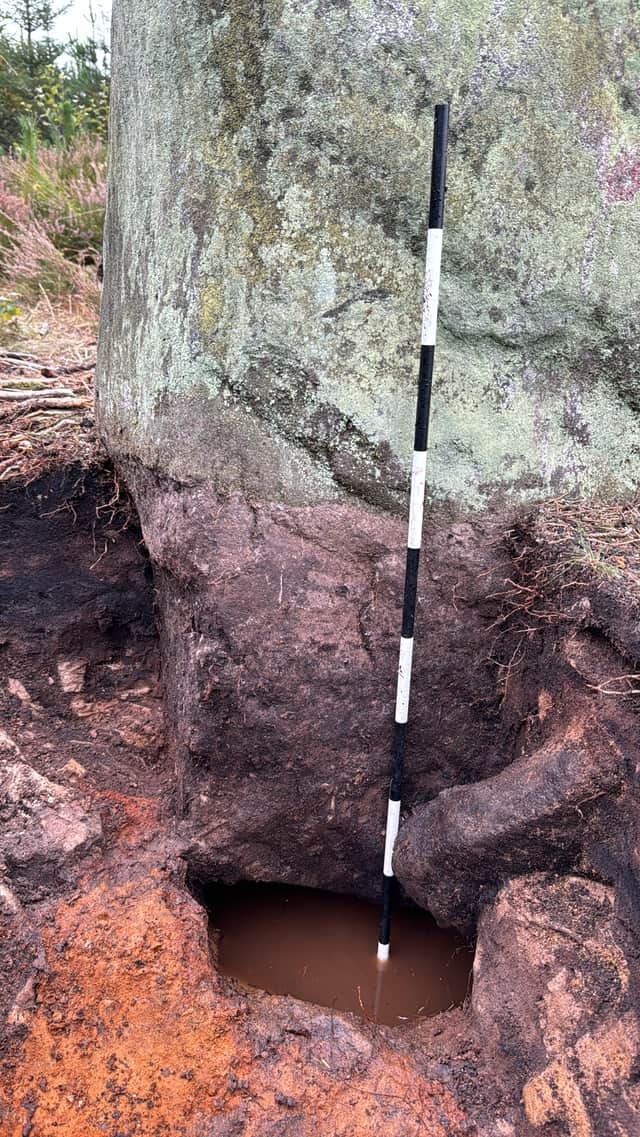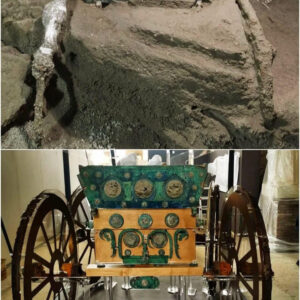Deep within the lush forests of Derbyshire, a remarkable discovery has reshaped our understanding of prehistoric Britain. What was once thought to be a solitary standing stone at Farley Moor has been revealed as part of a much larger ceremonial site, dating back 3,700 years to the Bronze Age. Excavations led by Forestry England and the Time Teamseries uncovered a hidden stone circle, transforming what was an isolated monument into a vital piece of the region’s ancient landscape. This groundbreaking find opens a window into the spiritual and social practices of early Bronze Age communities, offering a glimpse into a long-forgotten past.
The Farley Moor Standing Stone
At first glance, the Farley Moor standing stone seemed like a typical monument of the Bronze Age—a solitary marker in the landscape, standing 2 meters tall and half a meter wide. For years, this stone was believed to be an isolated remnant from the past, standing alone amidst the trees of Farley Wood. However, recent excavations have overturned these assumptions. Archaeologists have discovered that this seemingly solitary stone was actually part of a larger, intricate ceremonial site. It was never meant to stand alone but was positioned alongside five other stones, which together formed a circle, part of a larger ritual complex that stretched far beyond this one monument.
![The newly uncovered stone circle is believed to be a remarkable 3,700 years old, offering a rare window into ancient history. [Time Team]](https://historical.vncash24h.com/wp-content/uploads/2025/04/The-newly-uncovered-stone-circle-is-believed-to-be-a-remarkable-3-700-years-old-offering-a-rare-window-into-ancient-history-Time-Team.jpeg)
![A ceremonial platform was found nestled beside the central standing stone, hinting at its significance in ancient rituals. [Time Team]](https://historical.vncash24h.com/wp-content/uploads/2025/04/A-ceremonial-platform-was-found-nestled-beside-the-central-standing-stone-hinting-at-its-significance-in-ancient-rituals-Time-Team.jpeg)
Video
Watch the video 3,700-Year-Old Bronze Age Ceremonial Site Discovered in Derbyshire, Northern England to explore this remarkable archaeological find.
Unveiling the Stone Circle
What began as an investigation into the Farley Moor standing stone has now revealed the presence of a stone circle. The circle, which measures around 25 meters by 23 meters, consists of six original stones, with one still standing as the central marker. The significance of this discovery is immense, as it adds another layer to the rich prehistoric heritage of the Peak District. It is not just the discovery of another stone circle, but the revelation of a ceremonial landscape that would have been used for communal rituals and ceremonies, marking an important site for the people who lived in this region during the Bronze Age.
![According to Forestry England, this stone circle is one of 25 similar structures scattered across the Peak District, adding to the region’s rich archaeological landscape. [Time Team]](https://historical.vncash24h.com/wp-content/uploads/2025/04/According-to-Forestry-England-this-stone-circle-is-one-of-25-similar-structures-scattered-across-the-Peak-District-adding-to-the-regions-rich-archaeological-landscape-Time-Team.jpg)
The Role of the Natural Spring

One of the most fascinating aspects of the Farley Moor site is the discovery that the standing stone and its surrounding stone circle were deliberately placed above a natural spring. In Bronze Age societies, water was not just a basic necessity but also an element laden with spiritual significance. Natural springs, in particular, were often seen as portals to the divine, and their locations were frequently chosen for the construction of temples, ceremonial sites, and even burial mounds. The Farley Moor site’s proximity to water suggests that it was of great importance to the people who built the stone circle.
The spring likely played a central role in the rituals performed at the site, which could have included offerings, prayers, and ceremonial acts to honor water deities or spirits believed to inhabit the natural world. This connection between the stone circle and water underscores the spiritual depth of prehistoric communities in the area and their connection to the landscape around them.
Exploration and Excavation by Forestry England
The discovery of the Farley Moor stone circle was the result of a meticulous excavation led by Forestry England in collaboration with the Time Team archaeological series. The excavation process was extensive, involving a combination of traditional archaeological digging techniques and modern technologies, such as ground-penetrating radar, to uncover the hidden layers of history beneath the soil.
Dr. Lawrence Shaw, Forestry England’s lead historic environment adviser, described the discovery as “hugely significant” and emphasized that the site is a rare example of a well-preserved Bronze Age ceremonial landscape. The fact that such a complex site was hidden within a forest, away from the usual sites of large-scale monument building like Stonehenge, suggests that the ancient landscape was much more intricate than previously thought. Farley Moor, like many ancient sites, may have played a key role in the daily lives and spiritual practices of the communities that inhabited it.
![Archaeologists from the renowned Time Team joined forces with Forestry England to unearth new secrets of the past. [Time Team]](https://historical.vncash24h.com/wp-content/uploads/2025/04/Archaeologists-from-the-renowned-Time-Team-joined-forces-with-Forestry-England-to-unearth-new-secrets-of-the-past-Time-Team.jpg)
Bronze Age Ceremonial Landscapes
This discovery of the Farley Moor stone circle fits into a broader pattern of ceremonial monuments found across Britain and Europe, many of which served as centers of ritual and community life. Stone circles were a prominent feature of the British Bronze Age, and the Peak District, with its wealth of prehistoric monuments, was clearly a focal point for such activities. The discovery of the Farley Moor stone circle, however, takes on particular importance due to its excellent preservation and the evidence that it was used for centuries as part of ongoing rituals.
While sites like Stonehenge often capture the public imagination, the Farley Moor discovery suggests that other, smaller sites were equally important in shaping the ritual landscape of the time. Archaeological evidence points to a complex network of stone circles, burial mounds, and sacred sites that connected communities through shared rituals. The Peak District, in particular, is home to 25 stone circles, and the Farley Moor site further enriches this prehistoric tapestry, offering new insights into the social and spiritual lives of Bronze Age people.
Future Excavations and Research
Though the recent excavations have revealed much, there is still much more to discover at Farley Moor. The archaeological team plans to return next summer for a more detailed investigation into the site, aiming to uncover further evidence of the site’s original function and its broader context in the prehistoric landscape. Researchers hope to determine the full extent of the stone circle and surrounding monuments, as well as gain a better understanding of the ceremonial practices that took place here.
Carbon dating and other scientific analyses will help pinpoint the exact time the stone circle was created and when it was abandoned. The findings could potentially reshape our understanding of the cultural and ritual practices of the Bronze Age communities in this region.
Video
Watch the video The Mystery of the Celtic Tomb to uncover the secrets hidden within this ancient burial site.
Conclusion: Uncovering the Past
The discovery of the Farley Moor stone circle is a groundbreaking revelation that not only expands our knowledge of Bronze Age Britain but also provides a new perspective on the ceremonial landscapes of ancient Europe. Farley Moor, once thought to be just a solitary stone, is now recognized as a key piece of a much larger prehistoric puzzle. As research continues, the stone circle at Farley Moor will undoubtedly reveal more secrets of the past, offering a glimpse into the spiritual and social lives of the people who inhabited this ancient land.
The significance of this site cannot be overstated. It highlights the importance of smaller, lesser-known sites in shaping our understanding of prehistoric life, and it demonstrates the value of ongoing archaeological work in uncovering the hidden histories of our ancestors. As more sites like Farley Moor are uncovered, we continue to learn more about the complex, rich world that existed long before written history, reminding us of the deep connection that ancient societies had with their landscapes and the rituals that defined their lives.



